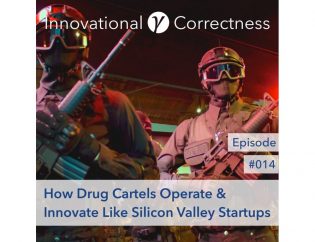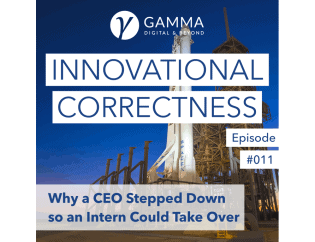This innovation & transformation podcast looks at innovators and companies that are changing the game and how they took their initial idea and created a game-changing product or service while giving you unique perspectives and insights you haven’t heard elsewhere. David and his guests discuss real-world practical advice on how to best harness the creativity of your employees and go from idea to product that has the potential to radically transform your business, all while separating hype from reality and replacing bullshit bingo with common sense.
Hosted on Acast. See acast.com/privacy for more information.
In dieser Episode werde ich erklären warum die digitale Transformation nichts mit Technologie zu tun hat und die meisten Mittelständler mehr Mut benötigen, das zu nutzen, was sie bereits haben. Ein Appell an den deutschen Mittelstand.
Ich erkläre warum:
- der Mittelstand bei der Digitalisierung bzw. Innovation oft hinter seinen Möglichkeiten zurückbleibt und wie er sich von den vermeintlichen Profis und damit meine ich primär Beratungen und Agenturen) über die Anforderungen an ihre Organisation einschüchtern lässt,
- sich diese Transformation mit traditionellen Denkmustern und Organisationsformen nicht erfolgreich umsetzen lässt,
- das scheinbar “neue” Thema eine uralte Herausforderung ist, die es schon seit Anbeginn des Industriezeitalters gibt
- und die Herausforderungen der Digitalisierung nichts mit Technik oder Technologie zu tun hat.
Show Notes, Transcription, & Resources Mentioned: gammabeyond.com/en/podcast/003
Podcast Website: www.innovationalcorrectness.com
—
If you enjoyed this episode, could I ask you for one small favor?
Would you please consider rating and reviewing this podcast on iTunes, Overcast or the podcast app of your choice? It really helps us out, by encouraging more people to find our podcast and reach hard-to-get guests.
Last but not least, if you have any suggestions for further episodes or guests should be invited on this podcast or just have feedback, shoot us a quick email: or fill out our feedback form.
Follow & add David on:
LinkedIn:linkedin.com/in/davidluna/
Youtube: youtube.com/c/GAMMADigitalBeyond
Hosted on Acast. See acast.com/privacy for more information.

Show Notes
Episode Contents
In dieser Episode werde ich erklären warum:
- der Mittelstand bei der Digitalisierung bzw. Innovation oft hinter seinen Möglichkeiten zurückbleibt und wie er sich von den vermeintlichen Profis und damit meine ich primär Beratungen und Agenturen) über die Anforderungen an ihre Organisation einschüchtern lässt,
- sich diese Transformation mit traditionellen Denkmustern und Organisationsformen nicht erfolgreich umsetzen lässt,
- das scheinbar “neue” Thema eine uralte Herausforderung ist, die es schon seit Anbeginn des Industriezeitalters gibt
- und die Herausforderungen der Digitalisierung nichts mit Technik oder Technologie zu tun hat.
Summary
- Die digitale Transformation hat nichts mit Technologie zu tun und die meisten Mittelständler benötigen mehr Mut, das zu nutzen, was sie bereits haben.
- Digitale Transformation ist nicht eine Frage der Technologie. Es ist vielmehr eine organisationale Transformation, auf die sich mittelständische Unternehmen vorbereiten müssen.
- Was wir heute durchleben, sind Prozesse, die vor mehr als 100 Jahren begonnen haben.
- Im Kern geht es darum wie bestehende Unternehmen es schaffen unter veränderten Bedingung zu innovieren und konkurrenzfähig zu bleiben. Wer sich bei diesen Veränderungsprozessen nur auf Technologien und die dahinterstehenden (digitalen) Geschäftsmodelle fokussiert, hat leider das ursächliche Problem nicht verstanden.
- Daraus folgt, dass Unternehmen ihren Umgang mit der Marktdynamik, -komplexität und Ambiguität entsprechend anpassen müssen.
- Unsere Welt ist zu komplex geworden und weist kaum mehr repetitive Bestandteile auf. Heute geht es vielmehr um Dinge wie kreative Problemlösung, Mut Neues zu probieren und mehr Agilität in sich schnell verändernden Märkten. Mit altertümlichen Denkmustern wird diese Komplexität und Ambiguität kaum zu meistern sein.
- Der Mittelstand muss die Komplexität und ihre Folgen endlich akzeptieren. Das heißt er muss auf vereinfachte Weltbilder verzichten und die Unvorhersagbarkeit und Intransparenz sowie Dynamik der Märkte hinnehmen und lernen damit entsprechend umzugehen. Der Fokus muss wieder auf die eigentliche Wertschöpfung (“Jobs to be done”) gelegt werden.
- Gute Entscheidungen werden mittels relevanter Informationen getroffen, nicht auf der Grundlage von möglichst vielen.
- Der Mittelstand steht sich mit seiner Hierarchie und Organisationsform selbst im Weg.
- Der Mittelstand versucht das Problem, resultierend aus einer funktionalen Teilung, mit einer neuen funktionalen Teilung zu lösen.Doch wenn der Mittelstand bei seiner tayloristischen Pyramidenstruktur bleibt, werden alle Versuche, der Herausforderung Herr zu werden, an der Organisation schlichtweg abprallen.
- Überkomplexe Strukturen verhindern, dass Unternehmen schnell genug auf Veränderungen reagieren können.
- Starre Strukturen fördern Silodenken und -handeln
- Interdisziplinäres Arbeiten auf der einen Seite jedoch zu fordern, auf der anderen Seite hingegen die starre funktional-hierarchische Unternehmensform beizubehalten, ist aus Mitarbeitersicht höchst widersprüchlich. Es ist so, als befehle der Chef: “Denke quer, aber halte dich bitte an unsere etablierten Grundsätze!”
- Macht und Struktur widersprechen der cross-funktionalen Vernetzung und Zusammenarbeit
- Führungskräfte müssen bereit sein, auf diesen Einfluss zu verzichten. Aber genau das fällt vielen Führungskräften und Geschäftsführern noch sehr schwer.
- Die digitale Transformation wandelt keinen Mittelständler in eine Netzwerkorganisation um. Eine übergreifende Vernetzung ist eine Frage der Geisteshaltung und nicht mit einer technischen Schnittstelle spezifizierbar.
- Der Mittelstand befindet sich inmitten einer Transformation.
- Der Mittelstand braucht keine Technologie-Nachhilfe, sondern muss stattdessen die Bewahrermentalität des Status Quo aus dem Weg schaffen.Dazu ist es zwingend notwendig, die eigene Sicht auf das Unternehmen, die Märkte, die Mitarbeiter und die gesamte Wertschöpfungskette grundlegend zu hinterfragen. Dazu müssen die richtigen Methoden und Werkzeuge zum Bewältigen der Komplexität ausgewählt werden.
- Die tayloristische Organisationsform ist eben nicht dazu geeignet, den Herausforderungen des 21. Jahrhunderts zu begegnen - selbst wenn man sie mit einem weiteren schönen 4.0-Buzzword verknüpft oder untermauert. Eine Fortführung dieser Organisationsform mittels einer neuen Abteilung und Zuständigkeit (CDO) ist keine zielführende Strategie.
- Der deutsche Mittelstand muss wieder den Mut finden, wirklich Neues anzupacken, wenn er morgen noch mit gestalten möchte, anstatt sich vom digitalen Transformationsgeschwafel einlullen zu lassen.
Links & Resources Mentioned
Articles
- Der Mittelstand braucht keine digitale Transformation! (oder als PDF)
- German 'Digitalisierung' versus American innovation
Videos
People Mentioned
- Thorsten Dirks (ehem. CEO von Telefónica Deutschland)
Links
- Das sind Deutschlands geheime Weltmarktführer
- 50 Erfindungen, die die Welt veränderten
- Studie „Die volkswirtschaftliche Bedeutung der Familienunternehmen“
- U.S. Mass Surveillance Has No Record of Thwarting Large Terror Attacks, Regardless of Snowden Leaks, The Intercept
- NSA program stopped no terror attacks, says White House panel member, NBC News
- Volatility, uncertainty, complexity and ambiguity
- Analysis paralysis
- Over-Engineering
Follow/Add the Podcast Host/Guest on:
David C. Luna: LinkedIn
Note: This transcript of the episode was machine-generated and has not been edited for correctness. It’s provided for your convenience when searching. Please excuse any errors.
[00:00:00] Intro: welcome to innovation, Ole correctness, a podcast, all about innovation and transformation hosted by David Luna, author keynote speaker and founder of gamma digital and beyond David and his guests discuss real world practical advice on how to best harness the creativity of your employees and go from idea to product giving you unique perspectives and insights into their success.
[00:00:27] All while separating hype from reality and replacing bullshit bingo with common sense, let's jump right into the show.
[00:00:37] Host (David C. Luna): Welcome to another episode of the innovation or correctness podcast. So in today's episode, I will explain why Uber is not disruptive and explain why almost everyone around you is probably misusing the term disruption and has been.
[00:00:52] Probably misapplying it for years, then we'll go through some of the different innovation types along with some prominent examples for each of them. [00:01:00] And we'll look at what actual disruption looks like, how it takes place by citing an example from the steel industry and show you how integrated steel mills dominating the steel industry for decades were completely blindsided and overrun by initially inconspicuous.
[00:01:17] Technology then I'll show you how to determine if an idea or even a startup has any disruptive, essential at all. Why Uber is not disrupting the cabinet industry, despite what the majority police and what you should focus on instead, so that your idea or company will increase its chances to become a disruptor.
[00:01:37] Themselves. So without further ado, let's get it tracking. So before I can explain in detail why Uber is not corruptive, we need to first have a clear understanding what disruption actually means. If you think you already know, then let me ask you the following question. Would you consider the first automobile?
[00:01:55] To be a disruptive technology. Now, even though the first automobile was [00:02:00] revolutionary, it did not affect existing markets. Remember the first automobile in the late 19th century or expensive luxury items of which very fewer actually sold the lower price affordable Ford model T was without a doubt.
[00:02:16] Disruptive as it overtook and displaced an existing market horse drawn carriages to be exact. Now, if your answer was no, it seems we already have a good understanding of what the definition that the godfather of innovation Clayton Christensen came up with. If your answer was no, then the following episode should actually.
[00:02:34] Proved to be very insightful and you'll have a much better grasp of what the concept of disruption really means that 90% of the people that use the term in daily business. So the term was first coined and defined by Clayton Christensen is famous for his Seminole book called the innovator's dilemma published way back in 1979.
[00:02:54] Today's concept of disruptive innovation is present in our everyday [00:03:00] language of innovation, but ironically, disruption theory is. Become a victim of its own success. So despite its broad usage, the core concept have been widely misunderstood and its basic principles have been misapplied. I'm always shocked by how loosely the term is passed around or how people roll their eyes at the mere mention of.
[00:03:20] Yes corruption. This is in part due to sloppy references from writers or journalists, and to make matters worse. It seems that they haven't read a serious part. Oh, critical on the subject. Oftentimes startups or even consult use the term so vaguely to invoke the concept in support or whatever it is there they wish to sell or convey, even though their product and service just simplifies an existing technology.
[00:03:46] Not displaces it. So I misunderstanding this one critical term. We lose much of the understanding and power of the innovator's dilemma. This is similar to the German companies using the term digital transformation. Everyone uses it. [00:04:00] Almost. Nobody can give you an accurate definition, and even if they did, they would.
[00:04:04] Come to realize and understand that digital transformation does not solve the problem of today's company in a VUCA world. Furthermore, if we use disruption or disruptive innovation to describe any situation in which an industry is shaken up or where incumbents fall well, the usage would be much too broad for obvious reasons.
[00:04:23] Applying the concept correctly matters in is. Actually critical in order to realize its benefits, a small competitor, that's still smart. Small parts of your market share can likely be ignored unless they're on a disruptive path. In which case it could be a very fatal threat to your company. However, both of these challenges need to be addressed fundamentally different.
[00:04:44] The concept of disruptive innovation is used to describe technology that. Up roots. And eventually it replaces an existing technology. Think of video streaming, eventually replacing or displacing video rentals. Now let's make the [00:05:00] distinction between sustaining breakthrough and disruptive innovation. So in order to really correct for yes, identify which innovation types we're dealing with, we need to talk about these three types of innovation.
[00:05:13] These will also be the definitions that I will use throughout this episode to stay consistent as not to lose the power of the contents. So sustaining or incremental innovation is essentially the continuous technological improvement to an existing product servers or process within the context of your existing business model.
[00:05:35] So essentially the goal is to do what you already. Do but much better now think of three bladed, razor becoming a five bladed one, generally the lion's share of innovation that happens in companies falls into this category, breakthrough innovation, or also Nate called radical innovation is a change to an existing product service or process that has a significant impact on the business, but still [00:06:00] fits within the company's business model.
[00:06:02] Think of the Motorola razor phone, even though it was a. It pushed the boundaries of design and was a huge runaway success for Motorola that sometimes allows company to you essentially leapfrog ahead of the company petition, but the innovation stays within the core offering. Finally, disruptive innovation is a new process, service or process that either creates the new market or interest at the bottom or low end of the market.
[00:06:29] And is it initially considered inferior through the existing offering as it moves up and displaces. Established incumbents again, think of streaming services such as Spotify or Netflix displacing the compact disk. The main reason disruption causes so much confusion is that it sounds like a major upset, which seems to suggest that the technological cause should be major as well.
[00:06:53] This in turn leads, many to falsely believe that disruptive innovation coincides with technical radical [00:07:00] innovation. So people end up confusing, disruptive with radical innovation. The opposite of disruptive is sustaining a disruptive innovation may or may not. Yeah. Represent a radical innovation. Also a radical break through may or may not be disruptive while an incremental innovation can be extremely disruptive.
[00:07:18] In fact, most documented cases of. Disruption originated from an incremental change. That was well within the technical capabilities of the incumbent. Now on the flip side, companies also have taken huge risks and engineered extremely complex new innovations that were hugely successful with their existing mainstream customers, but are considered sustaining, think of the Boeing seven, eight, seven now to better understand what.
[00:07:44] Actual disruption looks like and how it takes place. Let's look at a prominent example from the steel industry and industry. I've had the pleasure of working with extensively as I've helped companies, such as Klockner metals define their strategy and developed ways to disrupt their own industry. And what [00:08:00] we'll do is.
[00:08:00] Go through an example, examining the developments in the steel industry from the years, 1965 to the 1990s. Now let's enter the integrated steel mills. Yeah. Historically high quality steel objection was regarded as the domain of incumbents, the integrated steel plants and were. Unrivaled in terms of quality and production capability and capacity, there are large market share and higher added value, guaranteed success.
[00:08:27] But in the mid 1960s, many meals, steel-making started to become commercially viable, many meals pioneered by. Nucor employed, widely available techniques and equipment using electric arc furnaces to melt scrap steel, as opposed to the last furnaces to melt iron and then roll these into NPR products, such as bars, rods, beams, sheets, and by the way, integrated steel mills.
[00:08:52] Get their name from the integrated process of transforming iron or coal and limestone into final steel [00:09:00] shapes for instance, beams. And even though the. Integrated mills and mini mills look very similar scale is essentially the only differentiating factor mini meals use furniture that are roughly 20 meters in diameter and 10 meters high, which is where they get their name from.
[00:09:16] So let's take an example of a customer approximately. 8 billion us dollars. and this is a little outdated. Number two, build a competitive integrated steel requiring the output to be much greater than that of many meals, but in contrast, many meals can be built for much less than can produce. Steel at a fraction often less than a 10th to be exact of that, of an integrated mill making mini mills steel milking, a highly disruptive technology.
[00:09:43] Now you would think, wait a minute, why didn't every integrated steel company adopt this low cost mini mill technology, especially since steel is a commodity yet not a single integrated steel company had invested in a mini mill even after the technology [00:10:00] occupied, nearly half. Of North American steel production in the two thousands.
[00:10:03] Now let's look at how disruption finds its next lunch. Disruptive innovation usually starts out with a low quality product, say rebar, for example, in a low volume and or hello margin segment of a much larger and more mature market. The customers of this lower segment demand products or product attributes that mainstream customers like sheet metal customers do not, are not willing to give up performance for it.
[00:10:30] Or simply put the disruptive innovation is not good enough for mainstream customers, Marceau, mainstream customers, straight out reject that disruptive innovation, holding the incumbent hostage of its own success. And this is an important point to keep in mind now because many mill technology was inferior in the beginning.
[00:10:49] It could not provide all the higher quality steel Prague products as could the integrated steel mills and this stage new technology. And when I'm referring to technology, this also includes products and services. these new [00:11:00] technologies can either be inefficient or seem more expensive due to the fact that these technologies have not yet skilled or seem cheaper because they simply do less make sense, And just say, no business model. Disruption has similar patterns in respect to Martin channels, partners, revenue, et cetera. So this applies to business models as well. Now the reaction from the incumbents also falls a very predictable pattern. It is one generally of one of denial, similar to the five stages of grief.
[00:11:29] And for the more, the incumbent is forced to ignore the new technology. As it is often a market segment of low interest. Remember it's generally one of low volume, low margin, and does not really meet the growth requirements dictated by a much larger company size and as such the integrated steel mills.
[00:11:46] Exited the rebar market remembered it. It had only accounted for a very low volume, about 4% of the total market in tonnes and left it for the mini mills if he's done, essentially. So as time went on the [00:12:00] mini meals, she paid the rebar segment and started growing rapidly, solving their initial quality problems while retaining their cost advantage.
[00:12:08] Now, this is normally where the disruptor goes through a rapid learning curve solving further quality and performance issues, and suddenly, sorry. Threatening the incumbent in its main markets. So this would be something like angle rods. The integrated steel mill was then scrambled to put together a response, almost always this failed.
[00:12:27] So in this case, because the disruptors, headstart, and culture. That is much more adaptable or agile you would say today. Yeah. And then retreats into a higher end markets. So that would be something like structural steel. Ultimately, the market begins to demand the replacement of the incumbents technology with the new technology.
[00:12:46] And at this point, the whole market begins to see the potential in capabilities of the new technology. Essentially forcing the incumbent to move further up market. To say sheet steel and into a dead end with no market left to [00:13:00] go. And it's important to iterate. Disruption has little to do with technology or digital business models per se.
[00:13:06] That's why companies should not focus on the digital part of digital transformation or the digital transformation movement as they tend to do in Germany. But unfortunately this point is lost on most companies. So how do you determine if an idea or startup has any. Disruptive potential. we can do the following.
[00:13:23] We can do ask ourselves three questions to determine whether your idea or a particular startup has any disruptive potential, or when trying to change a sustaining innovation into the disruptive idea for greater growth potential. The first question is. Does it have low and disruption potential. Can you identify customers at the low end of the market who would be willing to purchase just a product with less, but good enough performance or features if they could buy it for cheaper, for a cheaper price.
[00:13:54] And is there a business model where you can. Earn significant profits at lower price in order [00:14:00] to acquire business over four overserved customer at the low end. And the second question pertains to, does it have new market disruption potential. So are there potential customers non-consumers at the moment who have not had the money, equipment or skill to do a certain tasks themselves and have therefore gone without it altogether, or have needed to hire someone with expertise to do it for them.
[00:14:23] So do these customers. Need to visit a central location physically or virtually in order to use the product or service. And then finally, you should ask yourself, does it disrupt at all? Is your idea disruptive to all relevant incumbents? If your idea appears to be sustaining a sustaining innovation. To one or more players, the chances will be stacked against you and the entrance.
[00:14:47] So often you will be unlikely to win that battle. Now, the examples for disruptive innovation are almost endless from hydraulic shovels, disrupting cable wind shovels in the early 20th [00:15:00] century is from PCs. Disrupting mainframe computers, online streaming disrupting retail, movie rentals, inkjet printers, disrupting laser printers, or even attender.
[00:15:09] We disrupting the PlayStation and Xbox. There are plenty. Now let's go back to the initial question and the title of this episode. Why is Uber not disrupting the cabin industry? without a question, Uber is certainly transforming the taxi business, but. Is it really disrupting the industry? And the simple answer is no.
[00:15:27] Now I'm sure you're not going to let me off the hook that easy, but I'll explain just because a company or a startup is highly successful, it doesn't automatically make it disruptive. Despite how many people define it as such wanting something to be a certain way does not make itself. Otherwise I would be a filthy rich millionaire on a.
[00:15:46] Private Island, but if you're still not convinced, let's go through some of the previous questions on how to determine if needed or startup has disruptive potential one by one and answering them for the case of Uber question one and [00:16:00] two pertain to low end or new market disruption, I've already outlined and explained disruption originates from two types of market, either low end or new market.
[00:16:09] So the low end disruption can take. Place because incumbents typically tried to provide their most profitable and demanding customers with improvements to their products and services, essentially paying less attention to less demanding customers and plus moving up market makes sense. So the previous mini-meal example is an excellent example for low end disruption, many mills per disruptor provided low end customers with good enough products.
[00:16:33] I think of rebars. And then over time slowly moved up in the case of new market disruption, disruptors create markets where none existed before, or simply put, they turn non-consumers into consumers by providing and simplifying technology. That new customers can use a good example of this. Was it personal computer that made it affordable and very simple to make calculations that were previously reserved for mainframe [00:17:00] computers.
[00:17:00] Now over did not start off from either low end or a new market. It would be very difficult for anyone to claim that Uber exploited a low end opportunity in the market. If that weren't the case. then that would have meant the cab providers were over-serving their customers by making cabs. As an example, too accessible to easy to use or providing too many caps.
[00:17:22] If anything, I would actually argue that Uber rides are more convenient and much more cleanli than your average cab. Now your mileage may wear may also over, did not serve us members that found existing alternatives too expensive or too inconvenient. So they took public transport or drove themselves instead.
[00:17:44] Remember Uber initially launched. Launched its service in San Francisco, a well-served market. And they typically cost 50% or more than a cab did. And that didn't even include surgery, pricing. Furthermore, Uber's customer. These were primarily people who already [00:18:00] hired rides. Now, Uber select, and that's currently a small part of Uber's overall revenue is an exception because the limousine or.
[00:18:06] Black car market, as they call it business is a far more likely to be on a disruptive path. And only time will tell if that's the case. Uber select essentially provides less expensive, a less expensive alternative to a traditional limousine and as such offering appeals to the low end of the limousine market, because customers are willing to sacrifice convenience.
[00:18:28] So the lack of advanced reservations. For savings. Now, what Uber has been doing though, is increasing the overall demand. Something that's quite common when someone develops a much better or cheaper solution to address a general customer need disruptors. On the other hand, start with either low end or unserved consumers, and then move up market to satisfy the mainstream.
[00:18:52] But Uber has followed the exact opposite trajectory. Growing its position in the mainstream market first and then moving to overlooked [00:19:00] segments. So most of what our strategy is, one of sustaining in addition over has actually also forced the state sponsored monopoly to compete cheat and become more customer focused and convenient.
[00:19:13] This is pretty evident by the fact that my taxi developed its own cab hailing app. After Uber continued to gain traction in European country. And this is a typical defensive strategy. When incumbents are faced with threats from sustaining innovations, they are highly mobile motivated to respond as opposed to flee when confronted with disruptive innovation.
[00:19:33] So in such cases, they deploy company additive technologies such as healing apps. From my taxi. Unfortunately, now that the cab business finally has real competition, they're once again, trying to hide behind government regulation, which will lead to less competition and innovation overall well, hurting all players involved in the long run.
[00:19:51] Now, one thing that should be noted, however, is the fact that Uber's performance can be considered and out Lauer liar due to the fact that. Cap markets are on the [00:20:00] round. The world are highly regulated in terms of pricing and entry barriers, cap providers rarely had to innovate. So this could at least in part explained why Uber has been so successful.
[00:20:10] So what do we learn from this episode? Let's put this all together over the past few years, you've probably heard countless keynote speaker speakers, cite Uber as a prime example for disruption, despite what others. Mike wants to believe Uber is not disrupting the taxi business. Even most innovation or business consultants don't even understand that most disruption originates from incremental innovation and what's worse.
[00:20:35] They should know better as they tend to throw around the term, like there's no tomorrow and get paid for it. Often these people use the term so loosely so that they can support whatever it is they're trying to sell or convey. Most of the time, their product or service really just improves or simplifies an existing technology.
[00:20:52] But if these people are still insistent Uber being disruptive, then they need to look for another definition that makes were fit within that [00:21:00] disruption category. And it needs to be concise. So by now, you should also be able to easily understand why Tesla is also not disrupting their respective industry.
[00:21:08] They're automotive industry. Now, even though many assume that high end electrical well vehicles are EVs, such as Tesla model S are disruptive. Eruptive innovation theory dictates a different undergrad, low speed electrical vehicle. Now there are seemingly disadvantage, such as low speed and limited driving range.
[00:21:29] Are actually classical hallmarks of disruption. They Pete on metrics of performance, such as simplicity, convenience, and affordability, that appeal to non-consumer essentially further democratizing the car, enabling more people who privilege he could not afford a car to enjoy its benefit. Now load speed EVs are particularly successful in China.
[00:21:50] Where they are targeting non-consumers who just can't afford a traditional car and are thus happy to embrace a low end alternative, but for low [00:22:00] speed EVs to be truly disruptive, if they will need to migrate to higher performance and higher profit margin markets, let's take another example. So the internet was not.
[00:22:10] A disruptive technology for Dell, but instead a sustaining innovation, those business model was already disruptive before they embraced the internet as a new distribution and communication channel. Remember selling PCs over the phone was very disruptive at the time as it cut out the middlemen, the retailers, this is also called disintermediation.
[00:22:32] If you want to be, if you want to use jargon, however, for compact HP and IBM, the internet. Would have had huge, disruptive impact. Now the important thing to remember here is what might constitute disruption for one person, but he might be a sustaining innovation or have a sustaining impact on another.
[00:22:50] And when you're the incumbent it's of utmost important to decide carefully, What you view as disruptive or not using a vague definition or calling everything [00:23:00] disruptive? certainly won't help and it could be your last move and yeah, sure. It's to the benefit of every competitor to claim that they are disrupting your industry, creating chaos causes untold confusion, especially in large corporations.
[00:23:13] Disruption has paralyzing effects on industry leader when attacked from below such an effective strategy, because. It's much more easier to beat incumbents when they are motivated Lee rather than fight. They're also motivated to go up market almost never interested in defending low end or new markets that the disruptive find so attractive.
[00:23:34] That's why you should never target an incumbent with a sustaining solution because they have the resources, the customer base and the motivation to fight any threat that is coming from the new competitor. Almost always. an established competitor win. If they are threatened with a sustaining technology, simply by doing more of what they're really good at satisfying their customers with incremental improvements, established players also frequently underestimate the rate of [00:24:00] technological progress that typically improves faster than their customers can keep up with.
[00:24:04] Even if they build a car that drives faster than that, of the competition, it will matter to the customer. If they're in heavy traffic, it makes sense. So what should you do instead? customers or people and companies for that matter hire products or services to get a specific job done. And consequently, you should segment your customer based on.
[00:24:23] Jobs, they are trying to get done by understanding the circumstances and the context of these customers that lack the money or the skill to finish. they'll be pleased with a simple inexpert pensive solution that has been previously beyond their reach. They will compare your disruptive product to having nothing at all.
[00:24:41] I can be completely delighted to purchase it, even though it may not be as good as other products available at a much higher price as a result, the barriers to entry required to satisfy these. New market customers or non-consumers are quite low. So technology that enables the dis disruption is quite complex, [00:25:00] right?
[00:25:00] Do you need to create it in a way that makes the purchasing process and the use of the product simple, convenient, or even foolproof. And this foolproof aspect is what creates growth by enabling your potential customers with less money and skill to begin consuming the product. So that was the end of this episode.
[00:25:17] I know this is a little bit shorter than you're used to, but if you found this. Episode interesting. And would like to go down the rabbit hole with disruption, then be sure to read my comprehensive disruption guide, why companies need to eat their children, which I've linked in the show notes as well.
Have feedback or recommendations for topics or guests?
Let us know, by filling out this short form here.

This podcast looks at innovators and companies that are changing the game and how they took their initial idea and created a game-changing product or service, while giving you unique perspectives and insights you’ve probably haven’t heard elsewhere.
David and his guests discuss real-world practical advice on how to best harness the creativity of your employees and go from idea to product or service that has the potential to radically transform your business.
They also share lessons they’ve learned along the way to effectively accelerate, incubate and scale innovations within small, medium and large enterprises, all while separating hype from reality and replacing bullshit bingo with common sense.
The show is hosted by David C. Luna, author, keynote speaker and founder of GAMMA Digital & Beyond.
The Innovational Correctness Podcast by GAMMA Digital & Beyond, David C. Luna is licensed under a Creative Commons Attribution-NonCommercial-ShareAlike 4.0 International License. Based on a work at gammabeyond.com/en/podcast/. Permissions beyond the scope of this license may be available by contacting us here.











